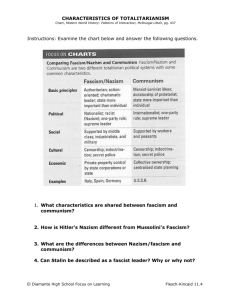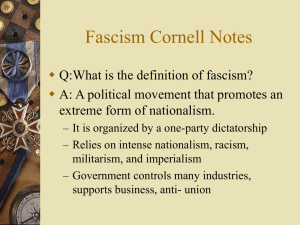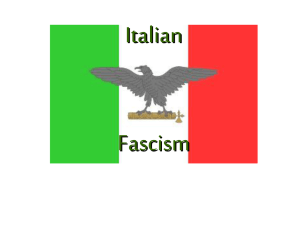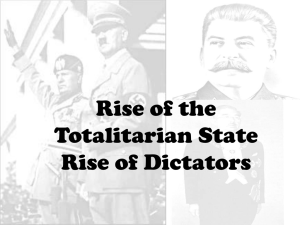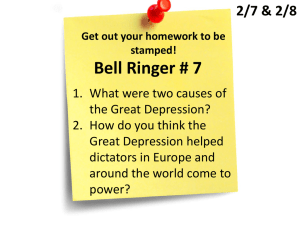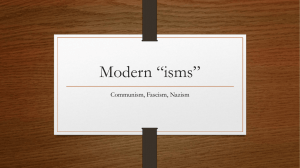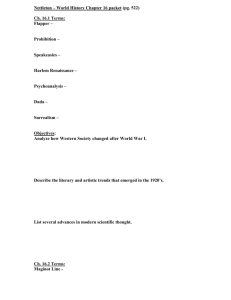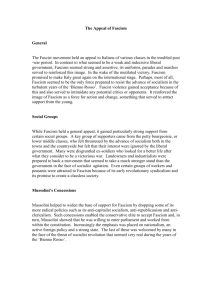The Origins of Fascism
advertisement
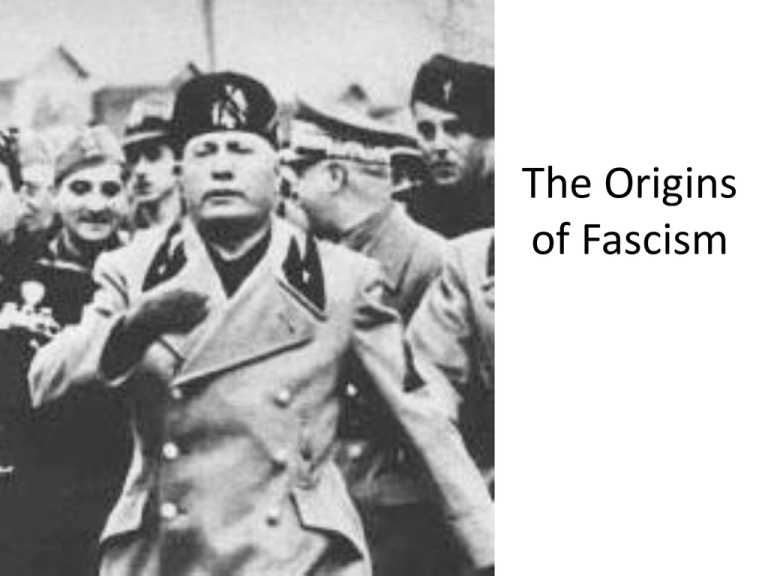
The Origins of Fascism The inaugural meeting of the Fascio Italiano di Combattimento (Italian Combat Group) took place in Milan on 23 March 1919. In attendance were 100 ex-servicemen and revolutionaries who had responded to an advertisement in Popolo d’Italia the newspaper founded and edited by Benito Mussolini, a journalist whose political affiliation had moved from pacifist socialist to interventionist following the outbreak of World War One. The meeting did not adopt a manifesto or rigid programme, however early ideas were essentially left wing and included: • Establishment of a Republic • Confiscation of Church lands • Land for the peasants • Tax reforms •Abolition of conscription • Votes for women Rather than creating a party Mussolini wished to create a movement with the flexibility to attract mass support. The first fascists represented a wide range of political views, they had little in common except a hatred of the Liberal State and a contempt for socialism. Early supporters of Fascism also included the Arditi – former members of Italy’s elite units who did not adapt easily to life in post-war Italy. Within days of the first meeting the ex – Arditi had destroyed the offices of the socialist newspaper Avanti! Support for fascism spread from Milan to other towns in Northern and Central Italy, notably Bologna and Trieste, however in the election of 1919 not one fascist was elected. Even in Milan they received only 4657 votes of a possible 270,000. It seemed as though the movement were doomed... The fascist breakthrough • Mussolini used Popolo d’Italia as a mouthpiece for the fascists. • The ideas of the fascists appeared to offer solutions to the problems of post-war Italy. • Fascism’s focus on national identity appealed to those who had fought in the war and to those who felt betrayed by the ‘Mutilated Victory’. • In 1919 the fascists presented a left-wing political programme which offered an alternative to disillusioned socialists. • Following the failure in the elections of 1919 the fascist programme moved to the right, which helped to win more conservative support. • In 1920 Mussolini began to use his ‘black-shirts’ to break strikes and won the support of conservative businessmen. • Violence brought notoriety to the Fascist movement and, provided it was directed against the left, went virtually unpunished. • By the end of 1921 fascism meant nationalism, anti-communism, strike breaking and patriotism. It became attractive to those who felt the liberal state no longer protected their interests. Rural Fascism • Rural fascism developed in response to the biennio rosso and the gains made by socialists. • Squadristi came from the towns and violently attacked socialist Labour Leagues. • Many liberals welcomed the violent action of the fascists, viewing them as defenders of the country against the threat of a left-wing revolution. • In areas where socialism was weak, fascism made no impact – rural fascism was a reaction to the strength of socialism. • By mid-1921 the rural socialists had been beaten and the fascist squadristi held control of the countryside. Partito Nazionale Fascista Giolitti viewed fascism as another political force that could be absorbed into the Liberal system. In May 1921 Giolitti offered Mussolini an electoral alliance in the hope of producing an anti-socialist governing coalition. The fascists secured 7% of the votes and won 35 seats. Mussolini was now a deputy with authority and respectability. In October 1921 a formal political party – the National Fascist Party – was established. Local branches were founded and new ‘respectable’ recruits were welcomed. This centralised body, firmly under the control of Mussolini, provided a counterweight to the local squads and their leaders. The Party had 200,000 members by the end of 1921 and gave Mussolini a real political power base. The PNF rapidly became the party of the middle classes, filling the vacuum left by the collapse of liberalism. • • • The main elements of fascism’s appeal were now: Anti-socialism An emphasis on patriotism The beginning of the cult of Mussolini (il Duce)
